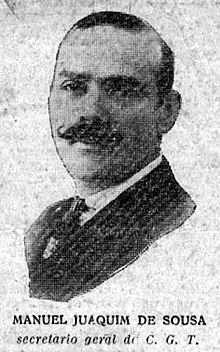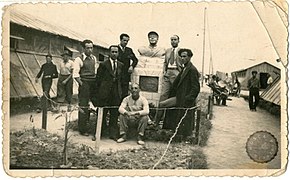Anarchism in Portugal
It was present from the first steps of the workers' movement, revolutionary unionism and anarcho-syndicalism had a lasting influence on the General Confederation of Labour, founded in 1919.
Along with trade unionism, propaganda was developed in particular by journalist José do Vale, editor of the newspapers O Petardo and La Dinamite.
A wave of individual attacks targeted journalists (such as Manuel Pinheiro Chagas in February 1888 for disrespecting Louise Michel), bosses, representatives of the State or the judiciary such as Judge Barros in 1896.
After the passage of the anti-anarchist law, many more anarchists integrated themselves into the syndicalist movement and joined the federation, provoking the organisation's leadership to dissolve itself back into the PSP.
[7] By the turn of the 20th century, trade unions in Portugal were largely dominated by the PSP; anarchists held a comparatively minor amount of influence.
As more local unions were formed, calls for unity between them led to national workers' congresses, which were held in Lisbon and Porto in July 1909.
[13] The fundamental principles and objectives of the CGT, adopted at this congress are: the free autonomous federation of workers; direct action – outside any political or religious influence – with a view to eliminating the wage system; the collectivization of the means of production; the internationalism of workers' solidarity and the elimination of capitalism.
It was only following the Bolsheviks seizure of power in Russia, and the subjugation of local workers' organizations to the Portuguese Communist Party, that this influence was marginalized.
[16] Influenced by the example of the Argentine Regional Workers' Federation, the objective was to strengthen the anarchist character of the Spanish National Confederation of Labour and the Portuguese General Confederation of Labour, by creating joint committees bringing together FAI members and trade unionists to move the union away from the influence of Republican political groups.
[17] The term Iberian referred to his desire to unify the Portuguese and Spanish anarchist movement in a pan-Iberian organization.
On 4 July 1937, a group of anarchists, including Emídio Santana, attempted to assassinate Salazar while he was going to mass,[19] but the dictator narrowly escaped the attack.
It was the Portuguese Communist Party which developed and which, with the support of the Soviet Union, became the main force in opposition to the dictatorial regime.
There have been some attempts to federate various anarchist and libertarian groups and individuals in modern times, with the main examples being União Libertária[20] and Rede de Apoio Mútuo.





